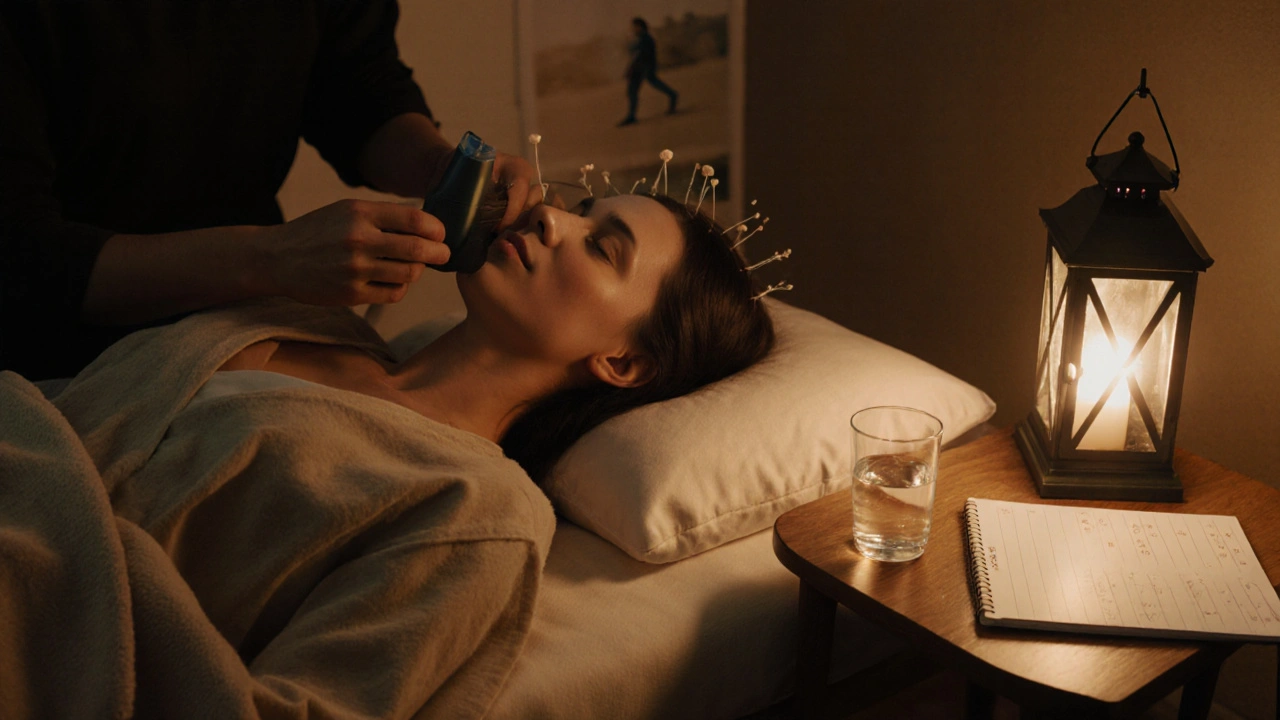COPD Treatment Comparison Tool
This tool compares key COPD outcomes between standard care alone and standard care combined with acupuncture, using data from clinical studies.
Dyspnea (Borg Scale)
Dyspnea (Borg Scale)
6-Minute Walk Distance
6-Minute Walk Distance
Exacerbations per Year
Exacerbations per Year
SGRQ Score
SGRQ Score
Important Note: These results are based on clinical studies showing average improvements. Individual results may vary based on factors like disease severity, treatment duration, and personal response.
Key Takeaways
- Acupuncture can ease breathing difficulty, reduce inflammation, and improve quality of life for people with COPD.
- Clinical studies show modest gains in lung function and exercise tolerance when acupuncture is added to standard medication.
- Safety is high when performed by licensed practitioners, but patients should discuss it with their doctor first.
- Treatments are usually short (20‑30minutes) and scheduled 1‑2 times per week for an initial 4‑8‑week course.
- Acupuncture works best as a complementary approach, not a replacement for inhalers or pulmonary rehab.
Living with an obstructive pulmonary disease such as chronic obstructive pulmonary disease (COPD) means dealing with shortness of breath, chronic cough, and frequent flare‑ups. While inhalers, bronchodilators, and pulmonary rehabilitation remain the backbone of treatment, many patients ask whether acupuncture for COPD can offer real relief. The short answer is yes - when combined with conventional care, acupuncture can address several symptom clusters and improve overall wellbeing.
Acupuncture is a therapy rooted in Traditional Chinese Medicine (TCM) that involves inserting thin needles at specific points on the body to balance the flow of vital energy (Qi). It has been used for millennia to treat pain, digestive issues, and respiratory problems.
Obstructive Pulmonary Disease, commonly referred to as COPD, is a progressive lung condition that includes emphysema and chronic bronchitis. It is characterized by airflow limitation, chronic inflammation, and reduced lung elasticity. According to the World Health Organization, COPD is the third leading cause of death worldwide, affecting over 250million people.
Why Acupuncture Might Help: The Biological Rationale
Modern research points to three main pathways through which acupuncture can influence respiratory health.
- Airway Inflammation reduction - Needle stimulation at points like Dingchuan (EX-B1) triggers the release of anti‑inflammatory cytokines (e.g., IL‑10) and suppresses pro‑inflammatory mediators such as TNF‑α.
- Lung Function enhancement - Studies using spirometry show modest improvements in FEV1 (forced expiratory volume in 1second) after 4‑6 weeks of acupuncture, likely due to relaxed smooth muscle in the bronchi.
- Immune Modulation - Acupuncture can balance Th1/Th2 immune responses, which helps control the chronic infections that often trigger COPD exacerbations.
What the Evidence Says
Several randomized controlled trials (RCTs) and systematic reviews have examined acupuncture as an adjunct therapy for COPD. Here are the most compelling findings:
- Symptom relief: A 2022 meta‑analysis of 12 RCTs (over 850 participants) reported a statistically significant reduction in dyspnea scores (Mean Difference=‑1.2 on the Modified Borg Scale) when acupuncture was added to standard medication.
- Exercise capacity: The same analysis found a 6‑minute walk test (6MWT) improvement of about 45meters, which exceeds the minimal clinically important difference (30m) for COPD patients.
- Exacerbation frequency: A 2021 Chinese trial followed 120 COPD patients for 12months. Those receiving weekly acupuncture had 30% fewer hospital‑recorded exacerbations compared with the control group.
- Quality of life: The St. George’s Respiratory Questionnaire (SGRQ) scores improved by an average of 8 points (the threshold for perceptible benefit) in acupuncture groups across multiple studies.
While the evidence is promising, it’s worth noting that most trials are small, and blinding is challenging. Nonetheless, the consistency across symptom, functional, and quality‑of‑life measures suggests a real therapeutic signal.

How a Typical Acupuncture Session Looks for COPD
When you first book an appointment with a licensed acupuncturist, expect the following flow:
- Assessment: The practitioner reviews your medical history, current inhaler regimen, and any recent flare‑ups. They may ask you to rate breathlessness on a scale of 0‑10.
- Point selection: Commonly used points include Dingchuan (EX‑B1), Feishu (BL‑13), Lieque (LU‑7), and Zusanli (ST‑36). Some practitioners combine respiratory points with general energy‑balancing points like Hegu (LI‑4) and Taixi (KI‑3).
- Needle insertion: Thin, sterile needles (0.20‑0.30mm diameter) are inserted to a depth of 5‑20mm, depending on the point. Gentle rotation or slight electrical stimulation (electro‑acupuncture) may be applied for 20‑30minutes.
- Post‑treatment advice: You’ll be encouraged to stay hydrated, practice diaphragmatic breathing, and monitor any changes in symptoms.
The typical course consists of 1‑2 sessions per week for 4‑8weeks, followed by a maintenance phase of monthly visits if benefits persist.
Safety, Contra‑indications, and Common Concerns
Acupuncture is generally safe when performed by qualified practitioners. Reported adverse events are mild and include bruising, temporary soreness, or faintness. Serious complications (e.g., pneumothorax) are exceedingly rare-about 1 in 10,000 insertions-and are avoided by using proper depth and technique.
Contra‑indications for COPD patients include:
- Uncontrolled bleeding disorders or anticoagulant therapy that cannot be paused.
- Severe cardiovascular instability (e.g., recent myocardial infarction).
- Active skin infection at the intended acupuncture site.
Because COPD patients often use multiple inhaled steroids, it’s a good idea to have the acupuncturist know about any antiplatelet or anticoagulant drugs you’re taking.
Integrating Acupuncture With Conventional COPD Management
Acupuncture should complement, not replace, the following cornerstone therapies:
- Bronchodilators (short‑acting and long‑acting) to keep airways open.
- Inhaled corticosteroids to control chronic inflammation.
- Pulmonary rehabilitation programs that include exercise training and breathing techniques.
- Vaccinations (influenza, pneumococcal) to prevent infections that trigger exacerbations.
When you discuss acupuncture with your pulmonologist, bring the following talking points:
- Reference specific studies (e.g., the 2022 meta‑analysis showing dyspnea reduction).
- Explain your goal-whether it’s to lower rescue inhaler use, improve sleep, or reduce anxiety about breathlessness.
- Ask for recommendations of licensed acupuncturists experienced with respiratory patients.

Practical Tips for Getting Started
- Check credentials: In New Zealand, look for practitioners registered with the Acupuncture Board of New Zealand (ABNZ) and who have experience with chronic lung conditions. \n
- Start with a trial period: Schedule 4‑6 sessions and track outcomes using a simple diary (breathlessness rating, inhaler use, sleep quality).
- Combine with breathing exercises: Techniques like pursed‑lip breathing amplify the benefits of acupuncture by promoting better airway pressure.
- Maintain medication adherence: Never skip inhalers unless your doctor advises otherwise.
- Monitor for side effects: Report any unusual pain, dizziness, or increased cough to both your acupuncturist and respiratory physician.
Comparison of Acupuncture Benefits vs. Standard Care Alone
| Outcome | Standard Care | Standard Care + Acupuncture |
|---|---|---|
| Dyspnea (Borg Scale) | ±0.3 change | ‑1.2 improvement |
| 6‑Minute Walk Distance | ±20m | +45m |
| Exacerbations per year | 2.5±0.8 | 1.7±0.6 |
| SGRQ Score | ±2 points | ‑8 points |
| Adverse Events | Medication side‑effects (e.g., oral thrush) | Minor bruising or soreness (rare) |
Frequently Asked Questions
Can acupuncture replace my inhalers?
No. Acupuncture is a complementary therapy. Inhalers remain essential for opening the airways quickly and preventing flare‑ups.
How many sessions are needed to feel a benefit?
Most studies report noticeable improvement after 4-6 weekly sessions. Individual response varies, so keep a symptom diary to judge progress.
Is acupuncture safe for someone with a pacemaker?
Yes, as long as the practitioner avoids needling directly over the device and follows standard precautions. Always inform both your cardiologist and acupuncturist.
Do insurance plans in NewZealand cover acupuncture for COPD?
Some private health funds reimburse acupuncture when a doctor provides a referral. Check your policy details or ask the clinic’s admin team.
What should I look for in an acupuncturist?
Choose a practitioner registered with the Acupuncture Board of NewZealand, with experience treating respiratory disorders, and who asks about your medication regimen.

Yo, so the pharma giants don't want us to know that acupuncture can actually chill the lungs – they’d rather push more pills. I read some hidden paper that says the needles pull out the "energy blockade" that meds can't touch. Anyway, just saying, keep an eye out.